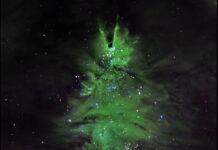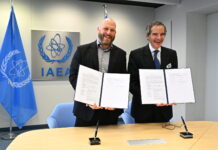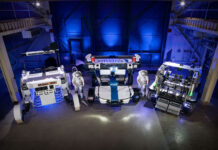Curiosity Rover’s Return to Familiar Martian Grounds: A Detailed Overview
In the latest update from NASA’s Curiosity Rover team, we find ourselves revisiting a notable region on Mars. The rover is currently positioned close to where it previously parked on sol (Martian day) 4253, specifically near a former scientific target known as "Discovery Pinnacle." This return is both momentous and meticulously planned, marking another chapter in Curiosity’s extensive exploration of the Red Planet.
A Glimpse into the Past
Back in July, during the last visit to this region, the Curiosity team was convening in Pasadena for their annual meeting. Coincidentally, this period also marked Curiosity’s 12th anniversary on Mars. The rover’s return to previously explored areas is an uncommon event, usually triggered by new observations or the need for additional data. For instance, the team once revisited a target named "Old Soaker" after identifying potential mud cracks in earlier images. This discovery was significant enough to warrant a return trip, as detailed in a NASA blog post.
Another notable revisit was the "walkabout" at "Pink Cliffs" in 2015, where Curiosity conducted a detailed survey of the area. These revisits, whether spontaneous or planned, provide invaluable data, helping scientists understand Mars’ geological history and its potential to have supported life.
The Journey from Discovery Pinnacle to Kings Canyon
In recent planning cycles, Curiosity’s journey has been deliberate and systematic. After departing from Discovery Pinnacle on sol 4253, the rover traveled through "Russell Pass" and eventually arrived at "Kings Canyon" on sol 4257. Kings Canyon was the designated drilling site, and the process, as always, was thorough and time-consuming, involving multiple steps and investigations.
During this period, the team celebrated Curiosity’s 12th birthday at Kings Canyon, a testament to the rover’s enduring legacy and the team’s unwavering dedication. After completing the drilling operations, the rover departed Kings Canyon on sol 4283, making its way back via "Cathedral Peak" to its current location near Discovery Pinnacle.
The Importance of Mars Reconnaissance and Re-exploration
Re-exploring previously visited areas is a crucial aspect of Mars reconnaissance. Each revisit is an opportunity to gather more detailed information, validate previous findings, and discover new insights. For instance, the re-examination of "Old Soaker" provided conclusive evidence of ancient mud cracks, suggesting that the region once experienced wet conditions.
Similarly, the "walkabout" at "Pink Cliffs" allowed scientists to conduct a comprehensive survey, leading to a better understanding of the area’s geological context. These revisits are not just about retracing steps but are strategic missions aimed at maximizing the scientific return from Curiosity’s exploration.
Today’s Mission Plan
With a rich history of exploration and discovery, today’s mission plan continues this legacy. The team is set to conduct a series of scientific investigations at the current location. These include detailed imaging, chemical analysis, and possibly even drilling, depending on the findings.
The primary objective is to build on the data collected during the previous visit. By comparing new findings with past data, scientists can piece together a more comprehensive picture of the region’s geological history. This iterative process of exploration and re-exploration is vital for advancing our understanding of Mars.
The Role of Technology in Mars Exploration
Curiosity’s ability to revisit and re-examine sites is a testament to the advanced technology onboard the rover. Equipped with state-of-the-art instruments, Curiosity can conduct a wide range of scientific investigations, from high-resolution imaging to complex chemical analyses.
One of the key instruments is the Mars Hand Lens Imager (MAHLI), which captures close-up images of rocks and soil. Another critical tool is the Chemistry and Camera complex (ChemCam), which uses a laser to vaporize rock surfaces and analyze their composition. These instruments, along with others, enable Curiosity to perform detailed scientific studies, making each revisit a valuable opportunity for new discoveries.
The Significance of Curiosity’s Mission
Curiosity’s mission on Mars is part of NASA’s larger effort to explore the Red Planet and search for signs of past or present life. Since its landing in 2012, Curiosity has traveled over 28 kilometers (approximately 17 miles) and climbed nearly 500 meters (about 1,600 feet) in elevation. Along the way, the rover has analyzed numerous rock samples, discovered ancient riverbeds, and provided evidence of past habitable conditions.
The data collected by Curiosity is crucial for future Mars missions, including the upcoming Mars Sample Return mission, which aims to bring Martian samples back to Earth for detailed analysis. By understanding Mars’ geological history and its potential to support life, scientists can better prepare for human exploration of the planet.
Community Reactions and Reviews
The scientific community and space enthusiasts alike have closely followed Curiosity’s journey. Each new discovery is met with excitement and curiosity, as it brings us one step closer to answering fundamental questions about Mars and our place in the universe.
Revisits to sites like Discovery Pinnacle and Kings Canyon have been particularly well-received, as they provide opportunities to delve deeper into previously identified features. The discovery of mud cracks at "Old Soaker," for instance, was hailed as a breakthrough, offering compelling evidence of ancient water activity on Mars.
Good to Know Information
For those interested in following Curiosity’s mission, NASA’s website offers a wealth of resources, including detailed mission updates, high-resolution images, and scientific papers. Additionally, the Mars Science Laboratory team regularly posts blogs and videos, providing insights into the rover’s daily activities and scientific discoveries.
Conclusion
Curiosity’s return to familiar Martian terrain is a significant event, underscoring the importance of re-exploration in planetary science. By revisiting sites like Discovery Pinnacle and conducting detailed investigations, the rover continues to contribute to our understanding of Mars’ geological history and its potential to support life.
As Curiosity embarks on this new phase of its mission, the scientific community and space enthusiasts eagerly await the next wave of discoveries. With each sol that passes, Curiosity brings us closer to unraveling the mysteries of the Red Planet, paving the way for future exploration and the eventual human presence on Mars.
For more Information, Refer to this article.


































